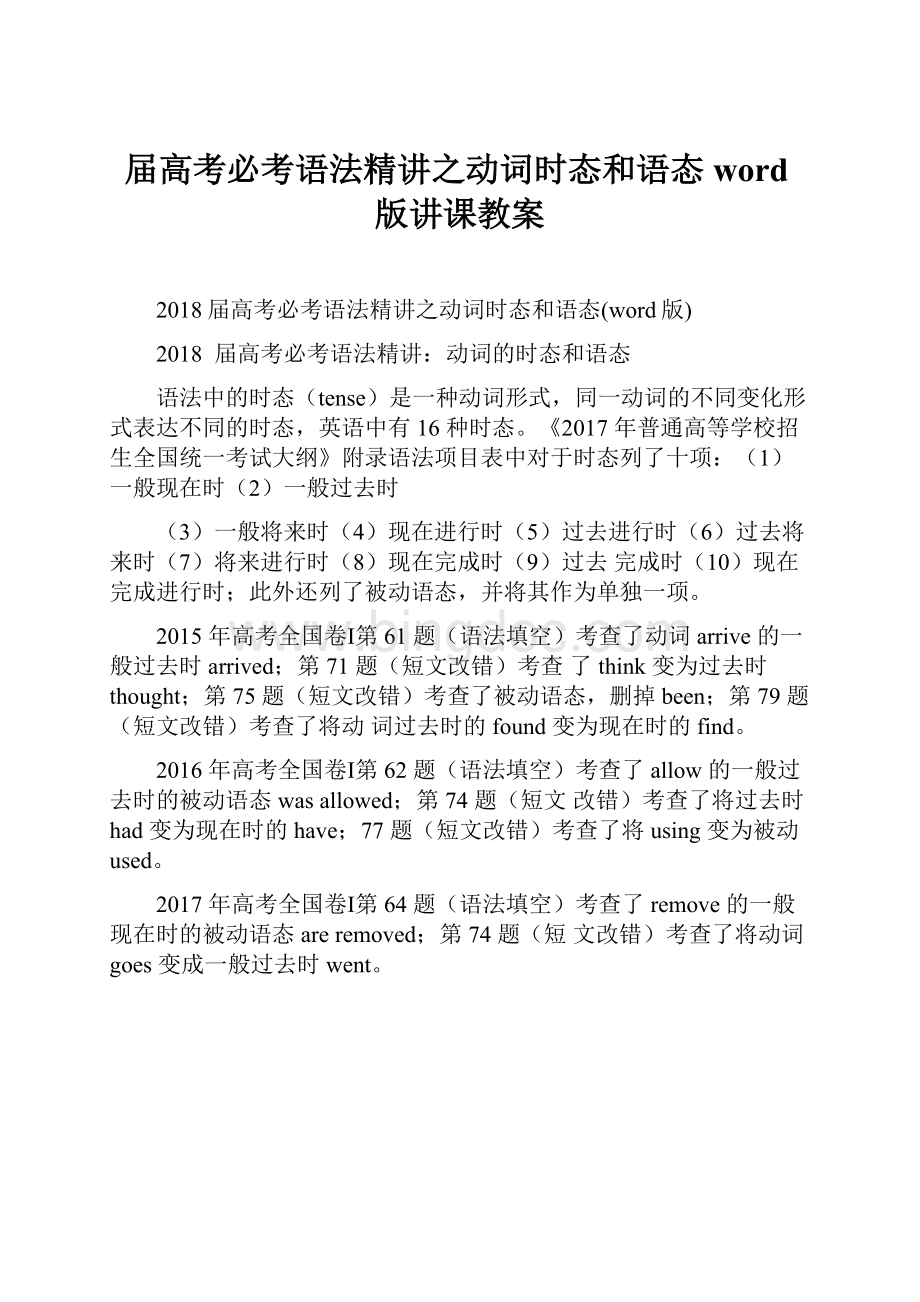届高考必考语法精讲之动词时态和语态word版讲课教案.docx
《届高考必考语法精讲之动词时态和语态word版讲课教案.docx》由会员分享,可在线阅读,更多相关《届高考必考语法精讲之动词时态和语态word版讲课教案.docx(20页珍藏版)》请在冰点文库上搜索。

届高考必考语法精讲之动词时态和语态word版讲课教案
2018届高考必考语法精讲之动词时态和语态(word版)
2018届高考必考语法精讲:
动词的时态和语态
语法中的时态(tense)是一种动词形式,同一动词的不同变化形式表达不同的时态,英语中有16种时态。
《2017年普通高等学校招生全国统一考试大纲》附录语法项目表中对于时态列了十项:
(1)一般现在时
(2)一般过去时
(3)一般将来时(4)现在进行时(5)过去进行时(6)过去将来时(7)将来进行时(8)现在完成时(9)过去完成时(10)现在完成进行时;此外还列了被动语态,并将其作为单独一项。
2015年高考全国卷Ⅰ第61题(语法填空)考查了动词arrive的一般过去时arrived;第71题(短文改错)考查了think变为过去时thought;第75题(短文改错)考查了被动语态,删掉been;第79题(短文改错)考查了将动词过去时的found变为现在时的find。
2016年高考全国卷Ⅰ第62题(语法填空)考查了allow的一般过去时的被动语态wasallowed;第74题(短文改错)考查了将过去时had变为现在时的have;77题(短文改错)考查了将using变为被动used。
2017年高考全国卷Ⅰ第64题(语法填空)考查了remove的一般现在时的被动语态areremoved;第74题(短文改错)考查了将动词goes变成一般过去时went。
各种时态构成表:
(以do为例)
一、一般现在时:
动词原形或第三人称单数
1.构成:
使用动词原形,第三人称单数须有变化。
(1)直接加“s”:
work→works,take→takes
(2)以辅音加“y”结尾,变“y”为“i”,再加“es”:
carry→carries
(3)以“o,s,x,ch,sh”结尾的动词加“es”:
go→goes,dress→dresses,watch→watches,finish→finishes2.功能:
(1)表现在的事实、状态或动作。
例如:
①Ihaveadream.
②Shelovesmusic.
③Mary'sparentsgetupveryearly.
(2)表习惯性动作或职业,常与often,sometimes,usually,always,everyweek,occasionally,frequently,seldom
等时间副词连用。
例如:
①Ialwaystakeawalkaftersupper.
②Shewritestomeveryoften.
③SheisanEnglishteacher.
(3)表客观真理,格言警句或事实。
例如:
①Theearthmovesaroundthesun.
②Thesunrisesintheeastandsetsinthewest.
③Twoandtwomakesfour.
④Nomanbuterrs.
(4)表示将来发生的动作:
A.在由when,after,before,as,assoonas,although,because,if,evenif,incase,till,until,unless,aslongas,where,whatever,wherever等引导的状语从句中用一般现在时表将来发生的动作。
例如:
①I'lltellherwhenshecomestomorrow.
②Evenifitrainsthisafternoon,I'llmeetyou.
③Whateverhappens,youshouldkeepcool-headed.
④I'llberightherewaitingforyouwhereveryougo.
B.按时间表将要发生的动作或事件,用一般现在时表达将来时概念。
例如:
①Theplaybeginsat6:
30thisevening.
②Whendoestheplanetakeoff?
③Heleavesforthatcitynextweek.
④Accordingtothetimetable,thetrainstartsat9o’clock.
二.一般过去时:
动词的过去式
1.表示过去某个特定时间或某一段时间发生的动作或情况。
例如:
①Wevisitedtheschoollastspring.
②IwenttoschoolbybikewhenIwasinmiddleschool.
③Chinawasfoundedin1949.
2.在表示时间或条件等的状语从句中代替过去将来时。
例如:
①Shetoldmeshewould’tgowithusifitrainedthenextday.
②Theywouldnotleaveuntilshecameback.
③Hisgirlfriendpromisedtomarryhimonceheboughtherabighouse.
三.一般将来时:
shall/will+动词原形
1.表示将要发生的动作或存在的状态。
例如:
①Hewillgraduatefromthecollegenextyear.
②Weshallfinishourworkasquicklyaspossible.
2.将来时的其它结构。
例如:
I.is/am/aregoingtodosth.(美国口语中常读作begonna)
①I'mgoingtobuyanewcarthisfall.
②Heisgoingtosellhishouse.
注意:
begoingto与will的对比:
下列情况须用will
①Iwillbesixteenyearsoldnextyear.
②Itwillbethe20thofAugusttomorrow.
③Whenhecomes,Iwillgivehimyourmessage.
II.is/am/are+todosth.表示计划安排做某事或征求意见。
例如:
①AmItotakeoverhiswork?
②Wearetomeetatthegate.
III.is/am/areabouttodosth.即将做某事。
例如:
①Thetalkisabouttobegin.
四.一般过去将来时:
would+动词原形
1.表示过去某时之后将出现的情况,通常用于宾语从句中。
例如:
①Hesaidthattheywouldmeetmeatthestation.
②Shetoldmethatshewouldcometoseeme.
2.表示过去习惯性动作(不管什么人称都用would)。
例如:
①Wheneverhehadtime,Tomwouldgotoseehisgrandma.
②Theoldcouplewouldgoforawalkaftersupper.
注意句型:
was/wereabouttodosth.when……正要做某事,这时……
=was/wereonthepointofdoingsth.when……(when引导的从句要用一般过去时)例如:
①Hewasabouttogooutwhenthetelephonerang.
②Iwasabouttogoshoppingwhenitrained.
③Shewasonthepointofhavingsupperwhenthelightwentoff.
五.现在进行时:
is/am/are+现在分词
1.表示现在正在进行的动作。
例如:
①Thewaterisboiling.ShallImaketea?
②Theworkersarebuildinganewbridgeacrosstheriver.
2.表现阶段正进行的动作。
例如:
①Heistakingphysicsthissemester.
②Wearepreparingforourfinalexaminationthisweek.
③Don'tyouthinkyoueattoomuch?
You'reputtingonweight.
3.go,come,leave,arrive,land,meet,die,start,return,join,etc.用于进行时态时表示即将开始的动作。
例如:
①Look!
Thebusiscoming.
②Theoldmanisseriouslyill,andheisdying.
③AliceisleavingforShanghaiwithhermother.
4.与always,forever,continually,constantly等副词连用,表示说话人带有感情色彩:
赞赏或厌恶。
例如:
①Heisalwaysthinkingofothers.
②Theboyiscontinuallymakingnoises.
③Theteacherisconstantlycriticizingherforbeinglate.
六.过去进行时:
was/were+现在分词
1.表示过去某一时刻或阶段正在发生的动作。
例如:
①Iwasplayingchessat8yesterdayevening.
②WhenIarrived,theywerewatchingTV.
③Theyweredoinghouseworkthistimelastweek.
2.用于条件状语从句中表示过去将来进行的动作。
例如:
①Shetoldmetowakehimupifshewassleeping.
②IaskedmyfriendtowarnmeaboutitaslongasIwasdrivingtoofast.
3.过去某时将发生的事。
例如:
①TheytoldmethattheywereleavingforNewYork.
②HewasgoingoutwhenIarrived.
七.将来进行时:
shall/willbe+现在分词
1.表示将来某个时刻正在进行的动作。
例如:
①Whatwillyoubedoingthistimetomorrow?
②Iwillbehavingdinnerthistimetomorrow.
2.用将来进行时询问别人的计划、打算比用一般将来时更显礼貌。
例如:
①Willyoubehavingsupperwithusthisevening?
②Willyoubecomingtoseeustomorrow?
3.将来进行时表示对即将发生的动作的推测。
例如:
①ShewillbearrivingatShanghaitomorrowmorning.
②Thecarwillbegoingatthespeedof100milesanhour.
八.现在完成时:
have/has+过去分词
1.表示过去所发生的动作对现在的影响或产生的结果。
常与yet,just,before,recently,lately,ever,never
等表时间的副词搭配使用。
例如:
①Hehasn'tseenherlately.
②Ihaven'tfinishedthebookyet.
2.表示一个从过去某个时间开始,延续到现在并可能持续下去的动作,常与表示一段时间的时间状语连用。
如:
sofar(迄今为止),uptillnow(直到现在),foralongtime(很长时间),,inthepast/inthelastfewyears(在过去的几年里),thesedays(这些日子)。
例如:
①Hehasworkedherefor15years.
②IhavestudiedEnglishsinceIcamehere.
③TheforeignerhasbeenawayfromChinaforalongtime.
④Sofar,Ihaven'treceivedasingleletterfrommybrother.
3.某些非延续性动词(即:
动作开始便终止的动词),在现在完成时中不能与表示一段时间状语搭配。
I.常见的非延续动词:
die,arrive,join,leave,go,refuse,fail,finish,buy,marry,divorce,awake,buy,
borrow,lend等。
II.这类动词并非不能用现在完成时,而是不能接常由for引导的时间状语。
III.但若是用在否定句中,非延续动词的现在完成时可以与表示一段时间的状语连用。
例如:
①Shehasgoneawayforamonth.(误)
②Shehasbeenawayforamonth(正)
①Themanhasdiedfortwoyears.(误)
②Themanhasbeendeadfortwoyears.(正)
①Howlonghaveyouboughtthebook?
(误)
②Howlonghaveyouhadthebook.(正)4.几组对比:
①HehasgonetoShanghai.他去上海了。
②HehasbeentoShanghai.他去过上海。
①Shehasgone.她已走了。
②Sheisgone.她缺席了。
(or她死了。
)
①Thedoorhasbeenclosed.门关上了。
(动作)
②Thedoorisclosed.门是关着的。
(状态)
九.过去完成时:
had+过去分词
1.表示过去某个动作或某个具体时间之前已经发生或完成的动作,即“过去的过去”。
例如:
①TheyhadgoteverythingreadybeforeIcame.
②TheplayhadbegunbeforeIgottothetheaterwithmyboyfriend.
2.过去完成时常用于hardly/scarcely...when,nosooner...than(“一……就”)等固定句型结构中。
例如:
①Shehadhardly/scarcelygonetobedwhenthebellrang.
=Hardly/Scarcelyhadshegonetobedwhenthebellrang.
②Hehadnosoonerarrivedattherailwaystationthanhemetherparents.
=Nosoonerhadhearrivedattherailwaystationthanhemetherparents.
注意:
hardly/scarcely/nosooner在句首时要用部分倒装。
3.intend(打算),mean(打算),plan(计划)hope(希望),want(想要)等动词的过去完成时用来表示“本打算/本计划/本希望/本想要做而没有”做的事。
例如:
①Ihadintendedtocallonyouyesterday,butsomeonecametoseemejustwhenIwasabouttoleave.
②Theyhadplannedtoholdafootballmatchlastweek,buttheyhadtocancelitbecauseofthebadweather.
十.将来完成时:
shall/willhave+过去分词。
表示将来某时之前已经完成的动作。
例如:
①Theywillhavebeenherefor5yearsnextFriday.
②Bytheendofthismonth,hewillhavefinishedthebook.
十一.现在完成进行时:
have/has+been+现在分词
1.表示从过去某时开始一直持续到现在的动作,并且还将持续下去。
例如:
①Ihavebeenwaitingforanhourbutshehasn'tcome.
②Hehasbeenrunningafterherfor8years.
③IhavebeenlearningEnglishsincesixyearsago.
2.表示一个从过去开始延续到现在,可以包括现在在内的一个阶段内,重复发生的行动,例如:
①Shehasbeenplayingtennissinceshewaseight.
3.表某种感情色彩。
例如:
①I'vebeenwantingtoseeyouforsomanyyears.
②Who'sbeentellingyousuchnonsense.
现在完成时与现在完成进行时对比:
现在完成时强调“结果”,而现在完成进行时强调“动作的延续”。
例如:
①Ihavethoughtofit.(我已想到了这一点。
)
②Ihavebeenthinkingofit.(我一直在想这一点。
)
①Jimhaspaintedthedoor.(杰姆已将门油漆过了。
)
②Jimhasbeenpaintingthedoor.(杰姆一直在油漆门。
)注意:
表示状态的动词不能用于现在完成进行时。
例如,我们可以说:
Ihaveknownhimforyears.但是不能说:
Ihavebeenknowinghimforyears.这类不能用于现在完成进行时的动词还有:
love,like,hate等等。
十二.过去完成进行时:
hadbeen+现在分词
表示过去某个时间之前一直在进行的动作。
例如:
①ShesaidthatshehadbeentypingapaperbeforeIcamein.
②Ihadbeenwaitingforhimbeforehearrived.
十三.过去将来进行时:
wouldbe+现在分词
表示从过去某时看将来某个时侯正在进行的动作。
例如:
①HeaskedmewhatIwouldbedoingwhenhecamethenextday.
②Hesaidthathewouldbereadingthebookallmorningtomorrow.
十四.过去将来完成时:
wouldhave+过去分词
表示从过去某个时间看将来某时之前动作已经完成。
例如:
①Hesaidthattheywouldhavearrivedbyseveno'clock.
②Ithoughtshewouldhavetoldyousomethingbythen.
十五.将来完成进行时:
shall/willhavebeen+现在分词
表示某一动作从某时间开始一直延续到将来某一时间,是否继续下去由上下文决定。
例如:
①Bytheendofnextyear,wewillhavebeendoingbusinesswitheachotherfor20years.
②WeshallhavebeenstayinghereforfourweekswhenTomarrives.
③Itwillhavebeenrainingforaweekifitdoesnotstoptomorrow.
十六.过去将来完成进行时:
wouldhavebeen+现在分词
表示从过去的某一时间开始一直延续到过去将来的某一时间。
动作是否继续进行,由上下文决定。
例如:
①HesaidthatbytheendofthespringtermhewouldhavebeenstudyingEnglishforthreeyears.
②Shetoldmethatshewouldhavebeenteachinginthatuniversityfor10yearsbythatsummer.
被动语态
一.被动语态的构成:
被动语态由“be动词+及物动词的过去分词”构成,其中be动词本身没有意义,但有人称、单复数以及时态的变化。
(不及物动词没有被动语态)
常见各种时态对应的被动语态:
(以do为例)
二.含有情态动词的被动语态:
由情态动词must/can/could/may/might/should/would+bedone构成。
例如:
①Thetaskmustbefinishedbeforethisweekend.
②Heshouldbepunishedbecausehetoldlies.
③Thebookmaybetakenawaybysomeone.
三.被动语态的用法:
1.不知道谁是动作的执行者,或没有必要指明谁是动作的执行者,被动语态中的介词短语bysb.通常省略。
例如:
①Thestreetsareswepteveryday.
②Hiscarhasbeenstolen.
③Riceisgrowninmanycountries.
④Thiskindofadvertisementcanbeseeneverywhere.2.带双宾语的及物动词变成被动语态有两种变法,指人的间接宾语用作被动语态的主语更常见。
例如:
①Hegaveherabeautifulgiftyesterday.
→Abeautifulgiftwasgiventoher(byhim).或者
→Shewasgivenabeautifulgift(byhim).